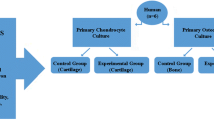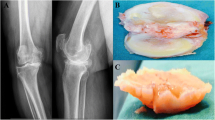Summary
Ciprofloxacin is a highly potent antibacterial agent that is used extensively in bone and joint infections. Because of reports of potential chondro-toxicity in animals, the effects of this drug on cells derived from human cartilage were tested in liquid micromass and agarose gel cultures. An inhibition of cell proliferation as indicated by a decrease in [3H]-thymidine uptake and bromodeoxyuridine labeling at ciprofloxacin concentrations of 0.5 and 50 mg/l was found which corresponded to the therapeutic and toxic serum levels. There was no effect on proteoglycan synthesis as indicated by35SO4 incorporation. Immunocytochemistry showed no changes in morphology or staining patterns for type-I procollagen, type-II collagen, keratan sulfate and unsulfated chondroitin. Because the amount of inhibition of DNA synthesis varied with different ciprofloxacin concentrations, this data suggests that this agent has a differential effect on newly differentiating cells and might be the basis for contraindication in pediatric patients.
Zusammenfassung
Ciprofloxacin ist eine hochwirksame antibakterielle Substanz, die in großem Umfang bei Knochen- und Gelenkinfektionen eingesetzt wird. Berichte über das chondrotoxische Potential dieser Substanz bei Tieren gab Anlaß für Experimente an menschlichen Knorpelzellen in Flüssig- und Agarose-Gel-Kultur. Als Beweis für die proliferationshemmende Wirkung von Ciprofloxacin bei Konzentrationen von 0,5 und 5 mg/l. d.h. Spiegeln, die den therapeutischen beziehungsweise toxischen Serumspiegeln entsprechen, ist die Abnahme der3H-Thymidine-Aufnahme und der Bromdeoxyuridin-Markierung anzusehen. Die durch35SO4-Inkorporation ermittelte Proteoglykan-Synthese ließ keinen Hemmeffekt von Ciprofloxacin erkennen. Immunhistochemisch waren keine Veränderungen in der Morphologie oder den Färbemustern für Prokollagen Typ I, Kollagen Typ II, Keratansulfat und nicht verschwefeltes Chondroitin festzustellen. Da die Hemmung der DNA-Synthese in Abhängigkeit von verschiedenen Ciprofloxacin-Konzentrationen variierte, ist auf einen gezielten Effekt auf neu sich differenzierende Zellen zu schließen. Möglicherweise ist dies die Basis für die Kontraindikation gegen eine therapeutische Anwendung der Substanz bei pädiatrischen Patienten.
Similar content being viewed by others
References
Adam, D. Use of quinolones in paediatric patients. Rev. Infect. Dis. 11 (Suppl. 5) (1989) 1113–1116.
Dagan, R., Schlaeffer, F., Einhorn, M. Parenteral fluoroquinolones in children with life-threatening infections. Infection 18 (1990) 237–239.
Schaad, U. B., Wedgewood-Krucko, J. Nalidixic acid in children: retrospective matched controlled study for cartilage toxicity. Infection 15 (1987) 165–168.
Schluter, G. Ciprofloxacin: toxicologic evaluation of additional safety data. Am. J. Med. 87 (Suppl. 5A) (1989) 37–39.
Wolfson, J. S. Quinolone antimicrobial agents: adverse effects and bacterial resistance. Eur. J. Clin. Microbiol. Infect. Dis. 12 (1989) 1080–1092.
Stahlmann, R., Merker, H. J., Hinz, N., Chahoud, I., Webb, J., Heger, W., Neubert, D. Ofloxacin in juvenile non-human primates and rats, arthropathia and drug plasma concentrations. Arch. Toxicol. 64 (1990) 193–204.
Tatsumi, H., Senda, H., Yatera, S., Takemoto, Y., Yamayoshi, M., Ohnishi, K. Toxicological studies on pipemidic acid. V Effect on diarthrodial joints of experimental animals. J. Toxicol. Sci. 3 (1978) 357–367.
Gough, A., Barsoum, N. J., Mitchell, L., McGuire, E. J., de la Iglesia, F. A. Juvenile canine drug-induced arthropathy: clinicopathological studies on articular lesions caused by oxolinic and pipemidic acids. Toxicol. Appl. Pharmacol. 51 (1979) 177–187.
Machida, M, Kusajima, H., Aijima, H., Maeda, A., Ishida, R., Uchida, H. L. Toxicokinetic study of norfloxacin-induced arthropathy in juvenile animals. Toxicol. Appl. Pharmacol. 105 (1990) 403–412.
Stahlmann, R. Safety profile of the quinolones. J. Antimicrob. Chemother. 26 (Suppl. D) (1990) 31–44.
Stahlmann, R., Blankenburg, G., Neubert, D. Studies on cartilage formation and differentiation in limb-bud culture in the presence of nalidixic acid, ofloxacin and ciprofloxacin. Rev. Infect. Dis. 10 (Suppl. 1) (1988) 147–156.
Ingham, B., Brentnall, D. W., Dale, E. A., McFadzean, J. A. Arthropathy induced by antibacterial fused N-alkyl-3-pyridone-3-carboxylic acids. Toxicol. Lett. 1 (1977) 21–26.
Ball, P. Ciprofloxacin, an overview of adverse experiences. J. Antimicrob. Chemother. 18 (Suppl. D) (1986) 187–193.
Schaad, U. B., Wedgewood-Krucko, J. Efficacy and safety of ciprofloxacin in paediatric patients with cystic fibrosis: Rev. Infect. Dis. 11 (Suppl. 5) (1989) 1118–1119.
Mankin, H. J., Dorfman, H., Lippiello, L., Zarins, A. Biochemical and metabolic abnormalities in articular cartilage from osteoarthritic human hips. II. Correlation of morphology with biochemical and metabolic data. J. Bone Joint Surg. 53A (1971) 523–537.
Green, W. T., Jr. Behavior of articular chondrocytes in cell culture. Clin. Orthop. 75 (1971) 248–250.
Frondoza, C. G., Widra, M. J., Jones, L. C., Hungerford, D. S. The effect of cytokines on the phenotypic expression of human articular cartilage cells in tissue culture. Trans. Orthop. Res. Soc. 37 (1991) 389.
Ahrens, P. B. A., Solursh, M., Reiter, R. S. Stage related capacity for limb chondrogenesis in cell culture. Dev. Biol. 160 (1977) 69–82.
Benya, P. D., Shaffer, J. D. Dedifferentiated chondrocytes reexpress the differentiated collagen phenotype when cultured in agarose gels. Cell 30 (1982) 215–224.
Boskey, A. L., Stimer, D., Doty, S. B., Binderman, I., Leboy, P. Studies of mineralization in tissue culture: optimal conditions for cartilage calcification. Bone Mineral 16 (1992) 11–36.
Delbruck, A., Bresow, B., Gurr, E., Reale, E., Schroder, H. In vitro culture of human chondrocytes from adult subjects. Conn. Tissue Res. 15 (1986) 155–172.
Gratzner, H. G. Monoclonal antibody to 5-bromo- and 5-iododeoxyuridine: a new reagent for detection of DNA replication. Science 218 (1982) 474–477.
Sleiss, J. L. Statistical methods for rates and proportions. 2nd ed. Wiley Co., New York 1981.
Forsgren, A., Brodberg, A., Riesbeck, K. New quinolones:in vitro effects as a potential source of clinical toxicity. Rev. Infec. Dis. 11 (Suppl. 5) (1989) 1382–1389.
Bredeberg, A., Brandt, M., Riesbeck, K., Azou, Y., Forsgren, A. The 4-quinolone antibiotics: positive genotoxic screening tests despite an apparent lack of mutation induction. Mutat. Res. 211 (1989) 171–180.
Someth, E., Schwartz, E., Rubinstein, E. The effects of pefloxacin and ciprofloxacin on bone marrow grafting in mice [abstr. no. 31]. In: Program and abstracts of the 27th Interscience Conference on Antimicrobial Agents and Chemotherapy. Washington, American Society for Microbiology, 1987.
Rusquet, R., Bonhommet, M., David, J. C. Quinolone antibiotics inhibit eukaryotic DNA polymerase α and β terminal deoxynucleotidyl transferase but not DNA ligase. Biochem. Biophys. Res. Commun. 121 (1984) 762–769.
Author information
Authors and Affiliations
Rights and permissions
About this article
Cite this article
Mont, M.A., Mathur, S.K., Frondoza, C.G. et al. The effects of ciprofloxacin on human chondrocytes in cell culture. Infection 24, 151–155 (1996). https://doi.org/10.1007/BF01713325
Received:
Accepted:
Issue Date:
DOI: https://doi.org/10.1007/BF01713325




